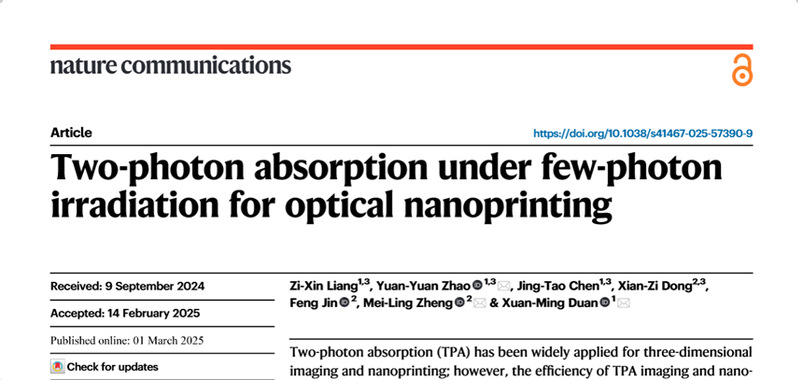- ABOUT JNU
- ADMISSION
-
ACADEMICS
- Schools and Colleges
-
Departments and Programs
- Arts College of
- Chinese Language and Culture College of
- Economics College of
- Electrical and Information Engineering College of
- Foreign Studies College of
- Information Science and Technology College of
- Environment School of
- Humanities School of
- International Business School
- International Studies School of
- Journalism and Communication College of
- Law School
- Liberal Arts College of
- Life Science and Technology College of
- Management School of
- Marxism School of
- Medicine School of
- Pharmacy College of
- Physical Education School of
- Science and Engineering College of
- Shenzhen Tourism College
- Research Institute
- Research Center
- Programs in English
- Majors
- Study Abroad
- Online Learning
- RESEARCH
- CAMPUS LIFE
- JOIN US
Breakthrough in Quantum Mechanism of Two-Photon Absorption: New Lithography Technology Developed by JNU Researchers
Author: Zhao Yuanyuan, Duan Xuanming
Publisher: College of Physics and Optoelectronic Engineering
Date: March 13, 2025
A research team led by Professors Zhao Yuanyuan and Duan Xuanming from the College of Physics and Optoelectronic Engineering at Jinan University has made significant strides in the field of optical super-resolution nanofabrication. Collaborating with Zheng Meiling from the Institute of Physical and Chemical Technology, Chinese Academy of Sciences, the team has elucidated the quantum mechanism of two-photon absorption (TPA) for the first time, resulting in the establishment of a spatiotemporal quantum model of the TPA effect. These findings were published in the prestigious journal Nature Communications under the title Two photon absorption under few photon irradiation for optical nanoprinting.

(Screenshot of the paper)
Key Findings
The team has developed a novel lithography technology based on few-photon two-photon absorption (fpTPA), which allows ultra-high resolution nanoprinting using extremely low light flux irradiation. The research highlights that two-photon absorption, typically used in three-dimensional imaging and nanoprinting, has its efficiency limited by traditional laser scanning techniques due to inherent resolution trade-offs.
The researchers unveiled a concept supporting fpTPA, which leverages the wave-particle duality of light to create a spatiotemporal model that describes the precise time-dependent mechanisms of TPA under ultralow photon irradiance. Their experimental results demonstrated that a feature size of just 26 nm (1/20 of the wavelength) and a pattern period of 0.41 λ were achieved using a tightly focused femtosecond laser pulse at a wavelength of 517 nm. This breakthrough in digital optical projection nanolithography under few-photon irradiation enhances printing efficiency significantly—by five orders of magnitude.
Research Implications
This work provides deeper insights into the two-photon absorption mechanism, opening up new avenues for exploring potential applications in nanoprinting and nanoimaging. The findings could have a profound impact on the development of advanced materials and devices at the nanoscale.
Support and Contributors
The research was supported by several major funding sources, including national key research and development programs, the Guangdong Special Support Program for leading talents in scientific and technological innovation, and various local scientific foundations. The paper lists Dr. Liang Zixin, Associate Professor Zhao Yuanyuan, Dr. Chen Jingtao, and Associate Researcher Dong Xianzi from the Institute of Physics and Chemistry as co-first authors, with Professor Duan Xuanming and Zheng Meiling serving as co-corresponding authors.
Read the full article: [Nature Communications]
(https://www.nature.com/articles/s41467-025-57390-9)
NEWS
- About the University
- Quick Links
Copyright © 2016 Jinan University. All Rights Reserved.




